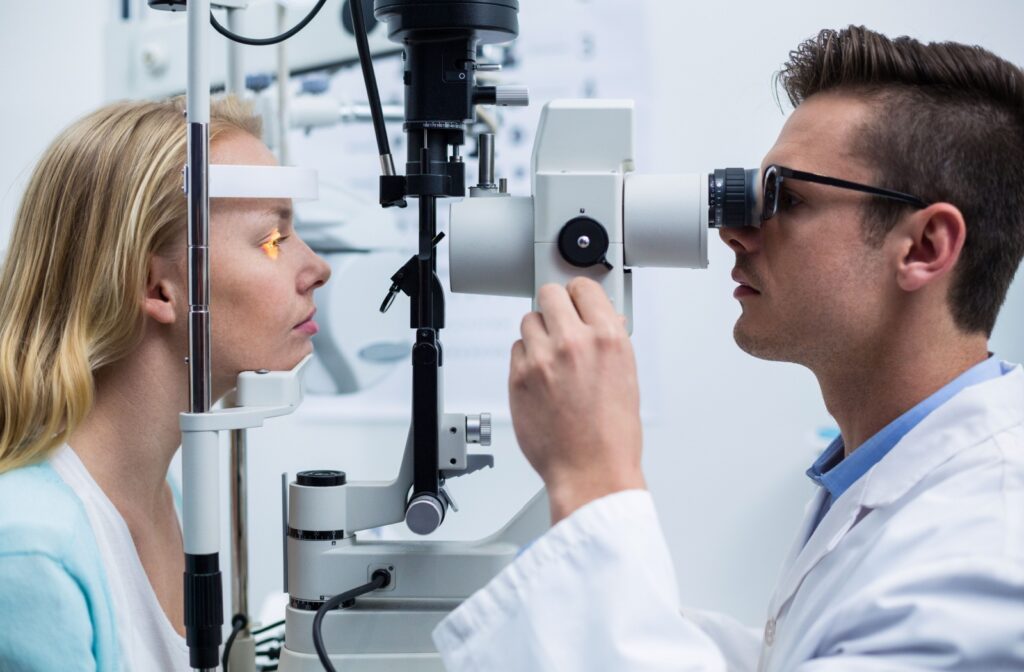Navigating the world of eyewear can be a puzzle. Many wearers of glasses have considered switching to contacts—however, the process can seem daunting. Prescriptions for glasses and contact lenses aren’t interchangeable, as each prescription uses different measurements. This is because contact lenses sit directly on your eyeballs, while glasses are offset a little bit from your eyes. In fact, to wear contact glasses, you’ll need to undergo a contact lens fitting.
This guide will help demystify the differences between prescriptions for glasses and contact lenses, providing you with the information you need to make an informed eye care decision.
Glasses vs. Contact Lenses
Eyeglasses and contact lenses serve the same primary purpose—to correct vision. However, they do so in different ways. Glasses are worn externally and sit about 12 millimeters from your eyes, while contact lenses rest directly on the surface of the eye. This fundamental distinction affects how each type of corrective lens is designed and fitted.
Glasses Prescriptions vs. Contact Lens Prescriptions
At first glance, you may think that glasses and contact lens prescriptions are the same. However, there are crucial differences. A glasses prescription includes measurements specific to lenses that sit away from the eyes, such as sphere (SPH), cylinder (CYL), axis, and pupillary distance (PD).
A contact lens prescription, on the other hand, includes additional information. In addition to SPH, CYL, and axis, it contains the base curve and diameter, which are essential for fitting lenses that rest directly on the eye’s surface. Contact lens prescriptions also specify the brand of contact lenses, as different brands may fit differently.
Are Contact Lenses or Glasses Better?
Both contact lenses and glasses have advantages. Choosing between them often depends on your lifestyle, preferences, and vision needs.
Eyeglasses offer ease of use, minimal maintenance, and a one-size-fits-all approach. They can also make a fashion statement and provide some protection from dust and debris. On the other hand, glasses are prone to fogging, can slip down your nose, and may interfere with activities like sports.
Contact lenses provide a more natural field of view without the peripheral distortion often experienced when wearing glasses. They’re ideal for active lifestyles; they don’t fog up or get in the way. However, contacts require regular cleaning and proper storage, and some people find them uncomfortable or difficult to insert.
Ultimately, the decision comes down to personal preference. Some people even wear glasses at home and contacts for sports or social events. Consulting with an eye care professional can help you explore the best option for your specific needs.
How to Read Glasses & Contact Lens Prescriptions
Reading your glasses or contact lens prescription can feel like deciphering a secret code. However, it’s pretty straightforward once you understand the measurements involved. Here’s a breakdown of the main elements you’ll find in each type of prescription.
Glasses Prescription
- Sphere (SPH): Indicates the lens power needed to correct nearsightedness or farsightedness.
- Cylinder (CYL): Measures lens power for astigmatism, if present.
- Axis: Specifies the orientation of astigmatism correction on the lens.
- Pupillary Distance (PD): Measures the distance between your pupils for proper lens alignment.
Contact Lens Prescription
- Sphere (SPH): Same as in glasses but tailored for lenses that rest on the eye.
- Cylinder (CYL) and Axis: Also similar to glasses but adapted for contact lenses.
- Base Curve (BC): Indicates the curvature of the lens to ensure a proper fit.
- Diameter (DIA): Specifies the lens size to cover the cornea adequately.
- Brand Name: Lists the specific brand of contact lenses prescribed for optimal fit and comfort.
Remember that only an eye exam can determine the correct prescription for your needs.
Can I Convert My Glasses Prescription to Contacts?
While it may be tempting to convert your glasses prescription for contact lenses, the reality is somewhat more complex. Because contact lenses rest directly on the eye, their prescription values are slightly different and include measurements that aren’t required for glasses. These measurements help contacts fit comfortably and function correctly.
If you want to switch to contact lenses, contact your eye care professional. They’ll conduct a contact lens fitting, which considers factors like the curvature of your cornea and the size of your pupil and iris. This ensures the lenses sit correctly on your eyes and provide the vision correction you need.

What to Expect from a Contact Lens Exam
If you’re considering contact lenses, you’ll need to have a contact lens exam. This specialized exam differs from a regular eye exam and includes several additional steps to ensure your lenses fit correctly and provide optimal vision.
- A keratometer measures the curvature of your cornea, which helps determine the base curve of your contact lenses.
- Your tear film will be evaluated to ensure your eyes produce enough moisture for comfortable lens wear.
- After selecting the appropriate lenses, you’ll receive a trial pair to wear. Your doctor will assess the fit and make any necessary adjustments. They’ll also teach you how to safely insert, remove, and care for your lenses.
A follow-up appointment is typically scheduled to monitor your comfort and vision, ensuring the lenses fit well and provide the necessary correction.
Keep Your Vision Clear
As L’occhio Eyecare-Eyestyle, we take the time to listen to your needs and find lenses that will meet your needs. Contact us today to book your contact lens exam and experience healthier vision and better comfort.




